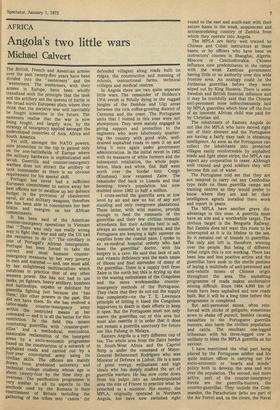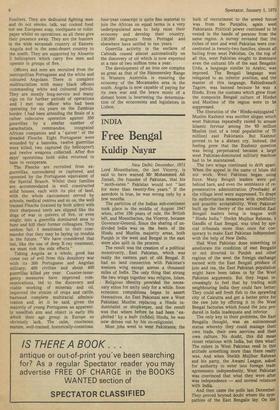AFRICA
Angola's two little wars
Michael Calvert
The British, French and American armies over the past twenty-five years have been divided into the 'easterners' and the westerners.' The westerners, with their armies in Europe, have been wholly transfixed with the principle that the tank and the artillery are the queens of battle in the broad north European plain where they think that the decisive war will inevitably be fought sometime in the future. The easteners realise that the war is now being fought, and largely won, by the strategy of insurgency applied amongst the undeveloped countries of Asia, Africa and South America.
Yet still, amongst the NATO powers, sure promotion to the top is gained only on the non-battlefields of Europe where the military hardware is sophisticated and lavish. Guerrilla and counter-insurgency warfare does not attract the artillery or tank commander as there is no obvious requirement for his special skill. Portugal has never had a sufficient European commitment to entice away her best officers nor to swallow up her defence budget in the provision of obsolescent naval, air and military weapons, therefore she has been able to concentrate her best brains and energies on her African commitments.
It has been said of the American counter-insurgency operations in Vietnam that "There was only one really wrong way to fight that war and only the US had the resources to do it." The corollary is true of Portugal's African insurgencies. Portugal has been forced to take the correct and most humane counterinsurgency measures by her very poverty in men and material — and, one must add, by her enlightened multiracialism which outshines in practice that of any other western power. She has not had to use tanks, jet fighters, heavy artillery, bombers and battleships, napalm or defoliant for guerrilla fighting just because she has them,' like other powers in the past. She did not have them. So she has evolved a tailor-made counter-insurgency army within the restricted means at her command — and it is all the better for this restriction. In the field this means countering guerrillas with ' counter-guerrillas ' and a methodical, meticulous, inexorable reclamation of the insurgent areas by a socio-economic programme based on the construction of a network of asphalted roads and carried out 'by• a four-year conscripted army using . its civilian skills. The officers are mainly drawn from graduated university and technical college students whose age is about twenty-four by the time they go overseas. The pacification programme is very similar in all its aspects to the methods used by the Romans in their resettlement of Britain including the gathering of the tribes into castra ' (or defended villages) along roads built on ridges, the construction and manning of schools, instructional farms, technical colleges and medical centres. In Angola there are two quite separate little wars. The remainder of Holdern's UPA revolt is fitfully dying in the rugged jungles of the Dembos and Uigi areas between the rich coffee-growing district of Carmona and the coast. The Portuguese units that I visited in this zone were not showpieces. They were mainly engaged in giving support and protection to the engineers who were laboriously quartering the country with good wide, welldrained asphalted roads to open it up and bring it once again under government administration. In the initial revolt in 1962 with its massacre of white farmers and the subsequent retaliation, the whole population, black and white, fled. Half went north over the border into Congo (Kinshasa), now renamed Zaire. The remainder fled back to Luanda and that booming town's population has now doubled since 1962 to half a million.
I cross-sected the guerrilla area at low level by air and saw no hut of any sort standing and only overgrown plantations. These latter, with wild manioc, provide enough to feed the remnants of the guerrillas and their few civilian nomadic attendants. But their Achilles heel is salt, always an essential in the tropics, and the Portuguese are keeping a tight squeeze on supplies from the coastal pans. I spoke to an ex-medical hospital orderly who had been the guerrillas' doctor, with his surgery in a cave. He said that lack of salt and vitamin deficiency was the main cause of illness and final surrender of many of the guerrillas. There is a supply trail from Zaire in the north but this is drying up due to the waning enthusiasm of the Congolese and the more workmanlike counter insurgency methods of the Portuguese. They claim that they do not cut the supply line completely—on the T. E. Lawrence principle of letting it bleed the Congolese supporters to death in their efforts to keep it open. But the Portuguese must not only starve the guerrillas out of this area but must also resettle it in order that it does not remain a guerrilla sanctuary for future use like Pahang in Malaya. Eastern Angola is a very different cup of tea. The whole area from the Zaire border to South-West Africa and the Caprivi Strip is under the command of MajorGeneral Bethancourt Rodriguez who was Minister of Defence in Lisbon. He is a man of great energy, enthusiasm and high ideals who has deeply studied the art of guerrilla warfare. He has now come down from his pulpit into an underpopulated area the size of France to practice what he preached as a minister. His enemy, the MPLA, originally operated in Northern Angola, but have now switched right round to the east and south-east with their secure bases in the weak, acquiescent and accommodating country of Zambia from which they operate into Angola.
The MPLA are fairly well trained by Chinese and Cuban instructors at these bases, or by officers who have been on instructors' courses in Shanghai, Algeria, Moscow or Czechoslovakia. Chinese influence now predominates in the camps with the weak Zambian government having little or no authority over this wide frontier area. An analogy could be the Jordanian guerrillas before they were wiped out by King Hussein. There is some Swedish and British financial influence and it may be truthfully said that the Chinese anti-personnel mine indiscriminately laid by MPLA guerrillas which blew off the foot of an innocent African child was paid for by Christian aid.
The inhabitants of Eastern Angola do not like the MPLA who have moved right out of their element and the Portuguese are having a fairly easy task in obtaining intelligence. As soon as the Portuguese can collect the inhabitants into protected villages easily reinforceable by asphalted roads and light plane strips, the MPLA can expect any cooperation to cease. Although well trained and good soldiers they will become fish out of water.
The Portuguese told me that they are not tempted to carry out any Cambodian type raids on these guerrilla camps and training centres as they would prefer to know where they are and let their intelligence agents installed there work and report in peace.
The MPLA have another grave disadvantage in this zone. A guerrilla must have an aim and a worthwhile target. The obvious target is the Benguela Railway. But Zambia does not want this route to be interrupted as it is its lifeline to the sea. So it remains out of bounds to guerrillas. The only aim left is, therefore, winning over the people. But being of different tribal origin this is not working. There has been less and less positive action and the guerrillas have sunk to the sterile pastime of laying a multitude of anti-personnel and anti-vehicle mines of Chinese origin throughout the area. The asphalting programme of roads makes unobtrusive mining difficult. Since 1964 4,000 km of roads have been asphalted and new roads built. But it will be a long time before this programme is completed. But anti-personnel mines, often reinforced with sticks of gelignite, sometimes sown to shake off pursuit, besides causing casualties to the Portuguese guerrilla hunters, also harm the civilian population and cattle. The resultant one-legged tribesman with his three-legged cow is unlikely to bless the MPLA guerrilla as his saviour.
I have mentioned the vital part being played by the Portuguese soldier and his quite mature officer in carrying out the socio-economic or hearts and minds' policy both to develop the area and win over the population. The second, and more active, part of the counter-insurgency forces are the guerrilla-hunters, the counter-guerrillas. They include the Commandos, the Parachutists (who are part of the Air Force) and, on the rivers, the Naval Fusiliers. They are dedicated fighting men and do not smoke, talk, eat cooked food nor use European soap, toothpaste or toilet paper whilst on operations, as all these give their presence away. They are the hunters in the wide savannah country of Eastern Angola and in the semi-desert country to the south. They are supported by Alouette 3 helicopters which carry five men and operate in groups of five.
Officers and men are recruited from the metropolitan Portuguese and the white and coloured Angolans. There is complete multiracialism with many black officers commanding white and coloured patrols. They are mostly long-service and many sign on for further periods of operations and I met one officer who had been operating for six years on the Zambian border. I had been attending the finale of a rather indecisive operation against 350 guerrillas by a similar number of parachutists, commandos, integrated African companies and a ' quiver' of the dreaded Flesche. Eight Portuguese were wounded by a bazooka, twelve guerrillas were killed, two captured (by helicopter!) and twelve weapons collected. After five days' operations both sides returned to base to recuperate.
The Flesche are recruited from exguerrillas, surrendered or captured, and operated by the Portuguese equivalent of the Special Branch. Whilst their families are accommodated in well constructed solid houses, each with its plot of land, with the whole cantonment served by schools, medical centres and so on, the well trained Flesche (trained by both sides) with their sharpened teeth are slipped like the dogs of war in quivers of five, or even singly, into a guerrilla dominated area to hunt and kill their former colleagues. They seldom fail. I mentioned to their commander that they may be laying up trouble in the future. "We have considered that but, like the use of deep X-ray treatment, we must risk the side effects."
Taking Angola as a whole, good has come out of evil from this desultory war with its 200 Portuguese and Angolan military, 409 civilian and about 400 guerrillas killed per year. Counter-insurgency measures have improved communications, led to the discovery and viable working of minerals and oil, improved the strains of crops and cattle, hastened complete multiracial administration and, let it be said, given the majority of young Portuguese an apparently unselfish aim and object in early life which their age group in Europe so obviously lack. The calm, courteous, mature, well-trained, historically-conscious, four-year conscript is quite fine material to join the African on equal terms in a very underpopulated area to help raise their economy and develop their country. 130,000 migrants from Portugal and elsewhere have settled in ten years.
Guerrilla activity in the enclave of Cabinda ceased almost automatically on the discovery of oil which is now exported at a rate of two million tons a year.
The development of an iron ore complex as great as that of the Hammersley Range in Western Australia is ensuring the economy of the Mocamades area in the south. Angola is now capable of paying for its own war and the brave music of a distant boom is heartening the determination of the economists and legislators in Lisbon.















































 Previous page
Previous page